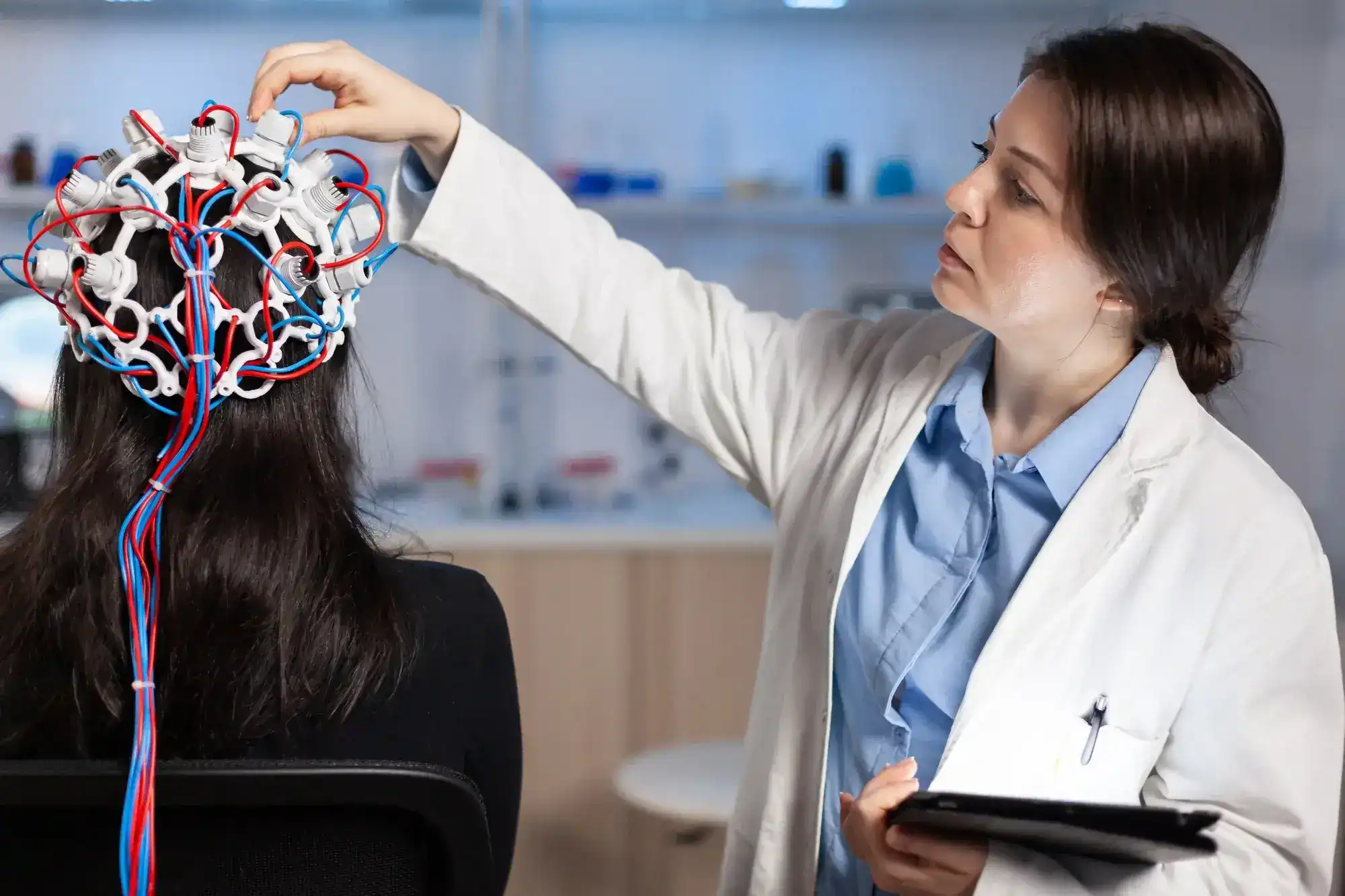Neurofeedback Therapy for ADHD: How Does It Work?

Living with ADHD can often feel like trying to focus with a million distractions racing through your mind. While medications are commonly used to manage symptoms, many are turning to neurofeedback for ADHD as a non-invasive alternative.
Instead of relying on medication, neurofeedback helps train the brain to regulate itself, improving focus and reducing impulsivity over time. If you’re looking for a treatment that addresses the root cause of ADHD, neurofeedback could be the solution.
Let’s explore how neurofeedback therapy for ADHD works and why it’s becoming an increasingly popular option for ADHD management!
What is neurofeedback therapy?
Neurofeedback therapy is a scientifically backed method to improve brain function by directly monitoring and training brainwave activity. It uses a technology called EEG (electroencephalography) to measure brainwaves and provide feedback in real time.
When the brain's activity is out of balance, it can lead to challenges like difficulty focusing or regulating emotions. Neurofeedback helps the brain learn to operate more efficiently by reinforcing healthier patterns of brain activity.
Over time, this process improves attention, emotional regulation, and behavior, addressing many core symptoms of ADHD.
ADHD: symptoms and challenges
ADHD stands for Attention-Deficit/Hyperactivity Disorder. It’s a condition that affects how the brain processes information. Common symptoms include:
-
Trouble paying attention: Forgetting tasks, losing focus, or daydreaming a lot.
-
Hyperactivity: Feeling restless, fidgeting, or having endless energy.
-
Impulsivity: Acting before thinking, interrupting, or struggling to wait for your turn.
While medications like stimulants (e.g., Ritalin, Adderall) can reduce symptoms, they don’t work for everyone. Some people may experience side effects like:
-
Trouble sleeping
-
Loss of appetite
-
Mood swings or irritability
Behavioral therapy is another option, but it takes time and commitment. Parents, especially, can find it hard to juggle therapy sessions with other responsibilities.
This is why alternative options like neurofeedback are becoming popular. They offer a new way to address ADHD by directly training the brain.
How does neurofeedback therapy help with ADHD?
Neurofeedback works by targeting brainwaves that affect attention and impulse control. People with ADHD often have imbalances in their brainwaves:
- Too many slow theta waves (which can cause inattention)
- Not enough fast beta waves (which help with focus and problem-solving)
The goal of neurofeedback is to reduce theta waves and boost beta waves to improve focus and self-control. It teaches the brain to balance these waves. Over time, the brain learns how to regulate itself better, reducing symptoms like distractibility and impulsivity.
Research supports the effectiveness of neurofeedback for ADHD treatment. Studies show that neurofeedback can help reduce ADHD symptoms, with improvements lasting 6 to 12 months. About 32-47% of people experience noticeable improvement, making it more effective than some other treatments. One study also found that neurofeedback improved motor skills, including speed and accuracy, with a notable effect size of 0.85.
Additionally, research suggests that the benefits of neurofeedback can persist, with improvements in attention span and behavioral control lasting up to six months post-treatment. It’s a safe and proven option with no major side effects.
Neurofeedback therapy for ADHD: The process
Here’s what the neurofeedback therapy process for ADHD looks like:
Step 1: Initial consultation and assessment
The first step is meeting with a neurofeedback therapist. They’ll:
-
Ask about your symptoms, goals, and medical history.
-
Perform a brainwave test (called an EEG) to see how your brain is functioning.
This assessment helps them create a personalized training plan just for you.
Step 2: Neurofeedback sessions
In each session, you’ll relax in a comfortable chair while electrodes are placed on your scalp to monitor your brain activity. You’ll be asked to watch a movie, listen to music, or play a game on a screen.
The idea is simple: when your brain produces the desired brainwaves, the screen stays bright, and the game runs smoothly. If your brain's activity drifts off track, the screen dims or pauses, providing a gentle reminder for your brain to adjust and get back on course.
Step 3: Treatment frequency and duration
Most people need 20-40 sessions for the best results. Sessions are usually done 2-3 times a week, and each one lasts about 30-60 minutes. The exact number depends on your needs and how quickly your brain learns.
Benefits of neurofeedback for ADHD
Neurofeedback has many positive effects on ADHD. Here are some of the key benefits you can expect from this therapy:
Improved attention and focus
Neurofeedback helps people with ADHD stay focused by balancing brainwave patterns. It boosts brainwaves linked to focus and reduces those tied to daydreaming. Research has shown that neurofeedback can significantly improve attention and cognitive performance.
Reduced impulsivity
Impulsivity is a common ADHD symptom that can make decision-making and emotional control difficult. Neurofeedback works by balancing brainwaves, which helps reduce impulsive behaviors. Studies show that children who undergo neurofeedback training tend to have better self-control, leading to improvements in both social interactions and school performance.
Enhanced emotional regulation
People with ADHD often struggle with emotional outbursts and stress. Neurofeedback helps by balancing brainwaves in the parts of the brain that control emotions, like the prefrontal cortex and amygdala. Research shows that neurofeedback can reduce emotional outbursts and help people with ADHD feel more emotionally stable overall.
Better sleep quality
Sleep issues are common for people with ADHD and can worsen symptoms like inattention. Neurofeedback can help by regulating the brainwaves that promote restful sleep. Studies have shown that neurofeedback can improve how quickly people fall asleep and enhance the overall quality of their sleep, leading to better attention and mood during the day.
Decreased anxiety and depression symptoms
ADHD often coexists with anxiety and depression, making it harder to manage. Neurofeedback helps by promoting self-regulation in brain areas responsible for managing emotions. Research shows that as ADHD symptoms improve with neurofeedback, anxiety and depression symptoms tend to lessen as well, leading to better mental health overall.
Are there any risks of neurofeedback therapy?
Neurofeedback therapy is generally safe for most people since it's non-invasive and doesn’t involve any medications or anything entering the body. However, some individuals may experience mild side effects, like feeling tired after a session or having a temporary headache. These side effects are usually short-lived and tend to go away as the brain gets used to the therapy.
Neurofeedback for ADHD vs. Medication
When it comes to treating ADHD, neurofeedback therapy and medication each has their own benefits. Medication tends to work quickly to reduce symptoms, but you need to take it every day, and the effects wear off once the medication leaves your system. Neurofeedback, on the other hand, takes a bit more time to show results but offers long-term benefits because it helps fix the underlying issue—imbalanced brainwave activity.
For many people, a combination of neurofeedback, medication, and behavioral therapy works best. This approach can give both immediate relief and lasting improvements. It's always a good idea to talk to your healthcare provider about the different options to find the treatment plan that works best for you.
How much does neurofeedback therapy cost?
The price of neurofeedback sessions can differ based on your location and the provider you go to. On average, sessions typically range from $75 to $150 each. If you're looking at a complete treatment plan, the total cost could reach several thousand dollars.
However, if you're looking for more budget-friendly options, countries like Turkey, Mexico, and Thailand offer high-quality neurofeedback therapy at a lower cost than the United States.
Looking for a cost-effective solution to ADHD treatment? Let QCG guide you to affordable neurofeedback therapy options worldwide!
Finding a qualified neurofeedback therapist
When choosing a neurofeedback provider, keep these factors in mind:
-
Look for therapists certified by the Biofeedback Certification International Alliance (BCIA).
-
Consider the doctor’s experience. A provider with a strong track record in treating ADHD is ideal.
-
Read testimonials and reviews from past clients.
Is neurofeedback therapy safe?
Yes, neurofeedback therapy is safe for children, teens, and adults with ADHD. It’s non-invasive, drug-free, and has minimal risks. Many families appreciate that it focuses on long-term brain health rather than temporary symptom relief.
Take the first step towards managing ADHD with neurofeedback therapy. Contact QCG now to find the best clinics and pricing abroad!

